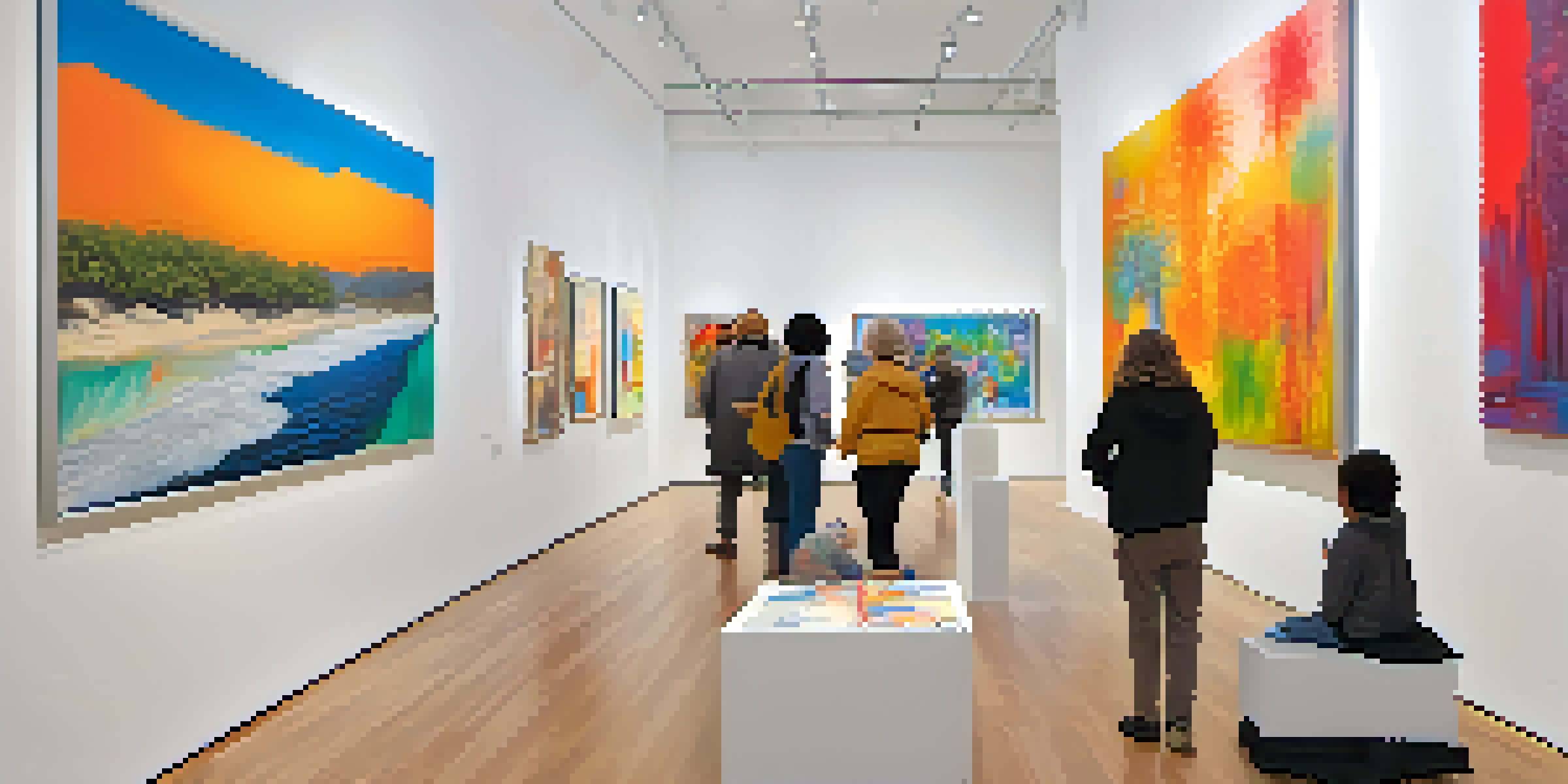Analyzing Global Art Market Reports: Key Insights

Understanding the Global Art Market Landscape
The global art market is a dynamic ecosystem influenced by various factors such as economic trends, cultural shifts, and technological advancements. It encompasses galleries, auctions, and private sales, creating a complex web where art is both a commodity and a cultural artifact. Understanding this landscape is crucial for artists, collectors, and investors alike.
Art is the most beautiful of all lies; it is a reflection of the world as it ought to be, not as it is.
Recent studies show that the art market has become increasingly globalized, with significant sales occurring in emerging markets. Cities like Beijing and Dubai have emerged as major players, challenging traditional hubs like New York and London. This shift not only reflects changing economic power dynamics but also highlights the diverse tastes and preferences of collectors worldwide.
Moreover, the rise of online platforms has revolutionized how art is bought and sold. Virtual auctions and online galleries have made art more accessible, allowing collectors from different regions to participate in the market. This democratization of art buying is reshaping the landscape, making it vital to stay informed about these trends.
Key Trends in Art Sales and Auctions
Analyzing recent art market reports reveals several key trends in sales and auctions. One notable trend is the increasing popularity of contemporary art, which is driving significant auction prices. Artists like Banksy and Yayoi Kusama are not just household names; their works are commanding staggering sums, reflecting a shift in collector interests.

Additionally, art sales at auction houses have seen a surge in digital participation. With platforms like Sotheby's and Christie's embracing online bidding, collectors can now compete for pieces from the comfort of their homes. This trend has broadened the market, attracting younger collectors who are more comfortable with technology.
Global Trends Reshape Art Market
The art market is increasingly influenced by globalization, with emerging markets like China and Dubai challenging traditional centers and diversifying collector preferences.
Another interesting trend is the rise of fractional ownership, allowing multiple investors to own a share of a high-value artwork. This innovative approach not only makes art investment more accessible but also diversifies ownership and engagement in the art market, creating new opportunities for collectors.
The Impact of Economic Factors on Art Prices
Economic conditions play a significant role in influencing art prices. During periods of economic growth, art sales typically flourish as collectors feel confident in their financial stability. Conversely, during economic downturns, luxury items like art can experience a decline in demand, making it crucial for stakeholders to monitor economic indicators closely.
In the end, the most important thing is that art is for everybody. It should be accessible and enjoyed by all.
For instance, during the COVID-19 pandemic, many predicted a dramatic fall in the art market. However, the opposite occurred in many sectors, with collectors turning to art as a safe asset. This resilience highlights how art can sometimes defy conventional economic expectations, emphasizing the need for ongoing analysis.
Moreover, currency fluctuations can also impact international art sales, as prices may vary significantly based on the buyer's location. Understanding these economic dynamics is vital for anyone involved in the art market, ensuring they can make informed decisions when buying or selling artworks.
Emerging Markets and Their Influence on Art
Emerging markets have become a critical factor in the global art scene, offering fresh perspectives and opportunities. Countries like China, India, and Brazil are not only increasing their presence in the art market but also shaping global trends with their unique cultural narratives. This shift is prompting collectors and galleries to expand their focus beyond traditional markets.
For example, the rise of Chinese contemporary artists has captured the attention of global collectors, leading to record-breaking sales at auctions. This newfound interest has encouraged more international exhibitions and collaborations, fostering a greater appreciation for diverse artistic expressions.
Technology Transforms Art Transactions
Innovations such as online platforms and blockchain technology are streamlining art purchases and enhancing authenticity verification, making art more accessible.
As these markets continue to grow, they introduce new buyer demographics and preferences, which can significantly impact overall market trends. Understanding these changes is essential for artists and collectors looking to navigate this evolving landscape effectively.
The Role of Technology in Art Transactions
Technology is revolutionizing the way art is bought and sold, making transactions faster and more efficient. Online platforms and mobile apps have streamlined the process, allowing buyers to discover and purchase art with just a few clicks. This has also opened up new avenues for artists to showcase their work to a global audience.
Moreover, the rise of blockchain technology is changing the way ownership and authenticity are verified. This innovative solution offers a secure way to track art provenance, reducing the risk of fraud and ensuring buyers are investing in legitimate works. As technology continues to advance, it promises to enhance transparency and trust within the art market.
Additionally, social media has emerged as a powerful tool for marketing art. Artists and galleries are leveraging platforms like Instagram to reach potential buyers directly, creating vibrant online communities around their work. This shift not only democratizes the art world but also allows for real-time engagement and feedback from collectors.
The Influence of Cultural Trends on Collecting
Cultural trends play an integral role in shaping what collectors seek in the art market. As societal values evolve, so do the themes and narratives that resonate with buyers. For instance, the increasing focus on social justice and environmental issues has led to a surge in demand for art that reflects these concerns, often referred to as 'activist art.'
This shift underscores the importance of artists aligning their work with contemporary issues, as it can significantly enhance their marketability. Collectors are increasingly looking to invest in pieces that not only have aesthetic value but also convey meaningful messages or stories, creating a deeper connection with their purchases.
Cultural Shifts Drive Collecting Trends
As societal values evolve, there is a growing demand for art that reflects contemporary issues like social justice and inclusivity, reshaping collector interests.
Moreover, the growing interest in diversity and inclusion in the arts has prompted collectors to seek out underrepresented artists. This trend not only enriches the art market but also fosters a more inclusive narrative that reflects the rich tapestry of global culture. Understanding these cultural dynamics is vital for anyone looking to thrive in today’s art landscape.
Navigating Challenges in the Art Market
While the art market presents numerous opportunities, it also comes with its fair share of challenges. One of the primary issues is the lack of transparency, which can make it difficult for both buyers and sellers to gauge the true value of artworks. This uncertainty can lead to overpaying or undervaluing pieces, highlighting the need for thorough research.
Additionally, the impact of art market speculation can distort prices, creating bubbles that may ultimately burst. Investors should be cautious and avoid making impulsive decisions based solely on market hype. Understanding the fundamentals of the art market is essential for mitigating these risks and making informed choices.

Finally, global events such as political instability or economic downturns can also disrupt the art market. Stakeholders must remain adaptable and resilient, continuously reassessing their strategies to navigate these challenges effectively. By staying informed and agile, collectors can thrive even in uncertain times.